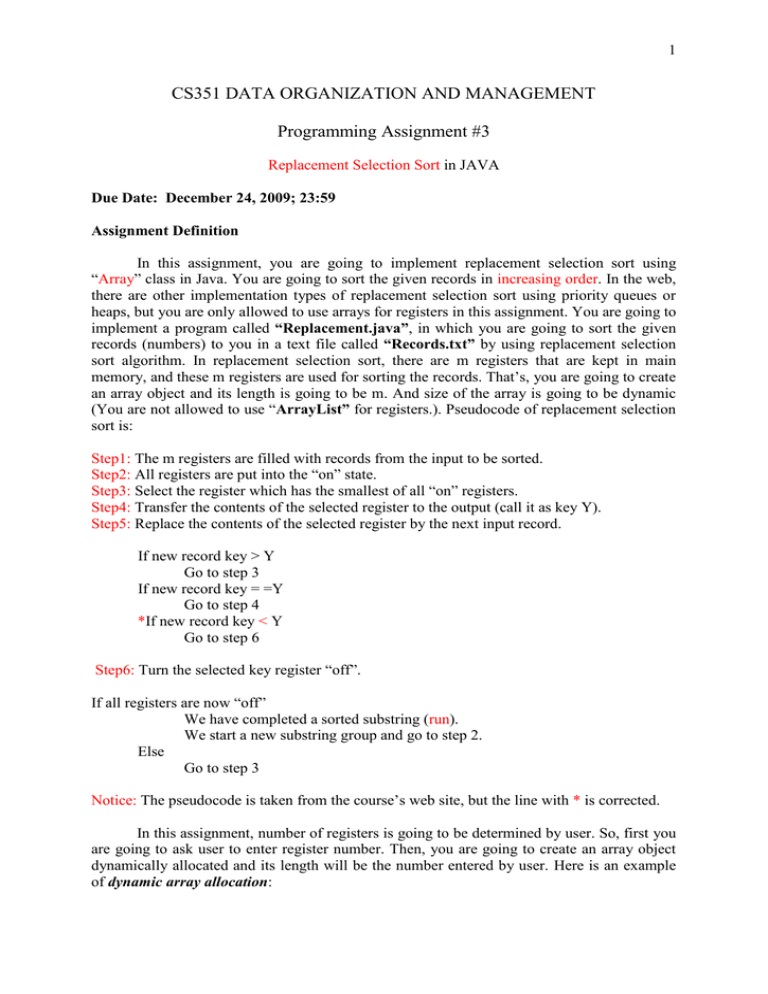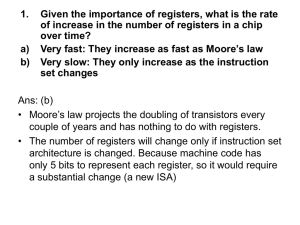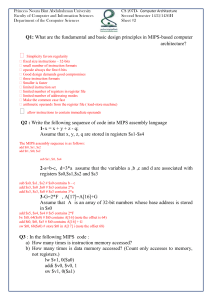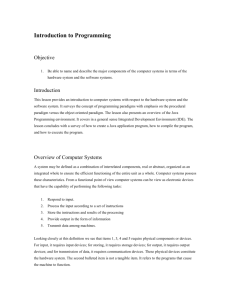docx
advertisement

1
CS351 DATA ORGANIZATION AND MANAGEMENT
Programming Assignment #3
Replacement Selection Sort in JAVA
Due Date: December 24, 2009; 23:59
Assignment Definition
In this assignment, you are going to implement replacement selection sort using
“Array” class in Java. You are going to sort the given records in increasing order. In the web,
there are other implementation types of replacement selection sort using priority queues or
heaps, but you are only allowed to use arrays for registers in this assignment. You are going to
implement a program called “Replacement.java”, in which you are going to sort the given
records (numbers) to you in a text file called “Records.txt” by using replacement selection
sort algorithm. In replacement selection sort, there are m registers that are kept in main
memory, and these m registers are used for sorting the records. That’s, you are going to create
an array object and its length is going to be m. And size of the array is going to be dynamic
(You are not allowed to use “ArrayList” for registers.). Pseudocode of replacement selection
sort is:
Step1: The m registers are filled with records from the input to be sorted.
Step2: All registers are put into the “on” state.
Step3: Select the register which has the smallest of all “on” registers.
Step4: Transfer the contents of the selected register to the output (call it as key Y).
Step5: Replace the contents of the selected register by the next input record.
If new record key > Y
Go to step 3
If new record key = =Y
Go to step 4
*If new record key < Y
Go to step 6
Step6: Turn the selected key register “off”.
If all registers are now “off”
We have completed a sorted substring (run).
We start a new substring group and go to step 2.
Else
Go to step 3
Notice: The pseudocode is taken from the course’s web site, but the line with * is corrected.
In this assignment, number of registers is going to be determined by user. So, first you
are going to ask user to enter register number. Then, you are going to create an array object
dynamically allocated and its length will be the number entered by user. Here is an example
of dynamic array allocation:
2
public class replacement
{
private static int[] register;
public static void main(String[] args)
{
// regNo is going to the number of registers entered by user
register = new int[regNo];
}
}
After creating an array dynamically, you are going to read first m records from
“Records.txt”. Then, you are going to follow steps given in the pseudocode. In this
assignment, you are going to sort the records in increasing order (as it is in the example given
in course’s web page), thus, in each iteration of the program, you are going to choose the
register which has the smallest record among all registers, and you are going to store that
record. You can store the sorted records until now in an “ArrayList” or however you like. In
the beginning of the program, all registers are turned on. But, when the program enters into
step 6, you are going to turn of the register after replacing the smallest record among registers
with the next record waiting in the list (as it is in the example given in course’s web page).
Turning a register off means that register is not going to be used for sorting anymore until
turning it on again. You can implement turning on and off processes as you wish in this
assignment. For example, you can use another dynamic array like the register array to store
condition of the register such as turned off or turned on. When all registers were turned off, it
means program completed a run successfully, and it is going to pass to next run by turning all
registers on. At the end of the program, you are going to print the records sorted in each run
on the screen.
In course’s web site, there is an example of sorting numbers given by using
replacement selection sort. In that example, register number is 3. Firstly, first 3 records
(numbers) are read into 3 registers. Then, steps given in the pseudocode are followed. When
program enters into step 6, the register is turned off. In the example, * symbol represents that
register was turned off. When all registers are turned off (*0*1*6 in the example), it means
program completed a run successfully, and we are passing to the next run by turning all
registers on. In the example, - symbol represents that the register is empty, which means there
are no records left to be sorted. For this example, at the end of the program, you are going to
print the records sorted in each run on the screen such as:
Run 1: 2 5 7 8 9
Run 2: 0 1 3 4 6
Record File (Records.txt) Structure
The record file (Records.txt) given to you is going to be like the given example record
file. If you look at “Records.txt” file, the records are separated with a coma (,) and all records
are stored in a single line such as “5,2,9,7,0,8,1,6,3,4”. In this file, each record is a non-zero
integer, so there will be no negative or floating numbers in this file. Besides, this file won’t
be empty, that’s, there will be at least one record in “Records.txt”. You don’t need to test your
program for these criteria.
3
Implementation
You will have only one java class, “Replacement.java” which will make these operations in
order:
ask user to enter the number of registers
create an array object dynamically allocated and its length will be the number
entered by user
read records from the text file “Records.txt”
follow the steps given in the pseudocode
print the records sorted in each run on the screen
Notifications
There is a good example of this assignment in course’s web page. The implementation
of this assignment will be same with that given example.
You don’t need to check any validation rules such as during testing process,
“Records.txt” file will be put in the same directory with your program.
During testing your program, the register number entered by user won’t be more than
the number of records in Records.txt file, so at the beginning of the program, registers
won’t be empty. Moreover, the register number entered by user won’t be less than 1
(zero or any negative number), which means 1 ≤ register number ≤ record number.
For storage of sorted records, you are allowed to use ArrayList, but for registers, you
are only allowed to use arrays dynamically allocated.
For correctness of your program, you can use given example Records.txt file. If you
enter 3 for register number as it is in the course’s web site, you can check if your
program works. But, this example won’t be enough to see if your program is working
completely. Testing your program with different register numbers and different record
files will help you to see if your program has any exceptions.
Testing Details
A sample record file is posted to the website to help you to see the structure of record file and
to test your program. This will not be the record file that will be used in grading your
program. While the record file provided should be useful, you should also do testing on your
own record file to ensure that your program works correctly. During your submission, you
will only submit “Replacement.java” which will be implemented by you.
Submission Rules
You will submit only one file: “Replacement.java” java class. You will put only this java
class into the winrar file will be StudentID_Name_Surname.rar (20491000_Emre_Celik.rar).
(Don’t use Turkish characters) Please don’t send the project file of programs like Eclipse or
Visual Studio. You will just put “Replacement.java” which is nested in “src” directory of
these programs. You can upload the same file for several times before submission due date.
Each time you upload a new file which has the same file name with your previously uploaded
file, your previously uploaded file will be substituted with the recently uploaded file. The
ones who do not obey the submission format will be penalized for 5 points. Late submissions
will not be accepted.
Upload Page: http://www.cs.bilkent.edu.tr/~yenicag/









